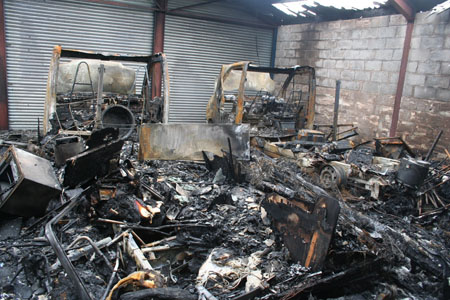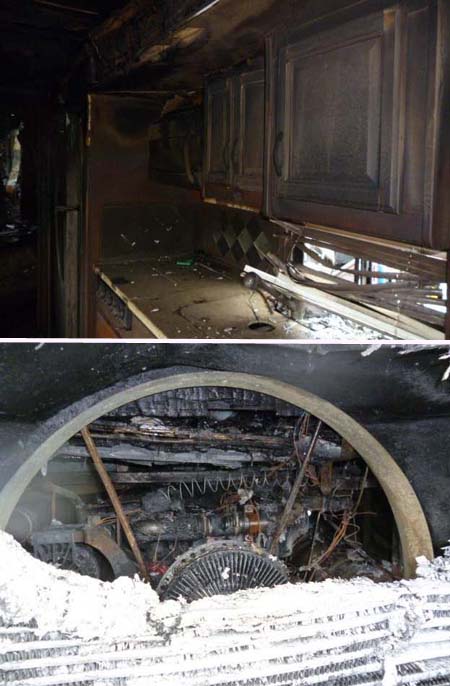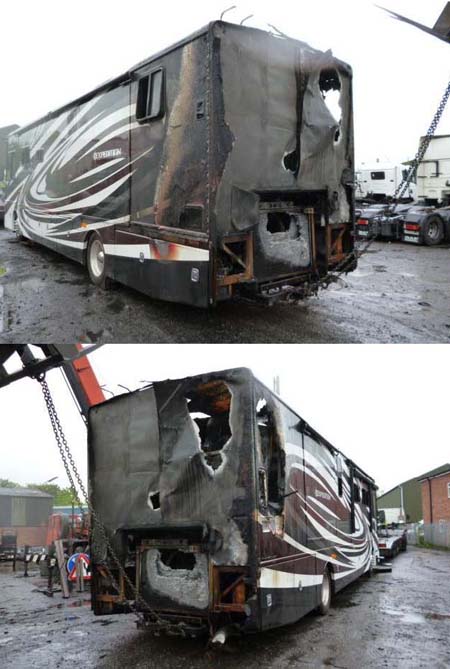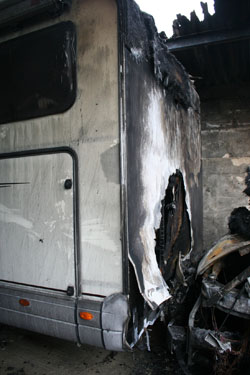Whether you are storing your motorhome at home or at a storage facility this winter, there are a few things to be aware of. This month we’re looking at the ways you can reduce the risk of fire damage – one of the most serious and most costly perils there is.

Similarly to storm and flood, fire can cause a huge amount of damage in a short space of time. Motorhome fires often result in the vehicle being written off and in extreme cases, can even cause fatalities.

Average value of fire claims
We looked into our claims records to give you a better idea of how severe fire claims can be.
The first thing that struck us was the costs involved; almost 46% of all motorhome fire claims were valued at £10,000 and over. On average, each claim cost £19,385.
Looking specifically at fire claims made whilst the motorhome was in storage, we discovered that the average claim cost considerably more at £26,296.
Where the risks lie
Most motorhome owners store their vehicle at home where the risk of fire is relatively low if the right precautions are taken. For motorhomes kept in storage facilities, the risks are slightly different. These facilities can house hundreds of motorhomes in one place, which not only increases the risk of fire but the threat of more widespread damage too. After looking at the total number of motorhome fire claims we found that over 30% happened when the motorhome was in storage.

Fire can also occur when the motorhome is in use. In these cases problems tend to arise because of electrical or engine faults. We’ve handled many claims where policyholders have noticed smoke coming from either the rear or under the bonnet of the motorhome. In fact, 14% of all motorhome fires happened whilst the motorhome was being driven.
We have also heard from customers who’ve been victim to motorhome fire whilst on holiday. When motorhomes are being used naturally the risks increase which is perhaps why claims of this sort are so varied. In one particular case a customer’s motorhome set on fire after a candle fell over, causing over £2000 worth of damage.
Preventing motorhome fires occurring in storage
Many motorhome fires are preventable. It’s recommended that motorhomes, their base vehicles and their habitation areas are serviced on an annual basis, even if the motorhome isn’t used that often. This is because problems can occur during long periods of storage.
It’s important to have the motorhome base vehicle serviced for two main reasons: it must be deemed roadworthy by a qualified mechanic and there must be no signs of deterioration on tyres, suspension, in the engine and in other areas.

A full habitation service for example, covers gas pipes and water heater checks, sockets and charging systems, alarms and ignitions, lights, exhausts, tyre pressure, seals and even fridges. Fridges are a surprisingly common factor in motorhome fires, in fact they account for 8% of all motorhome fire claims. Fires claims caused by faulty fridges cost £9,201 on average which shows just how crucial habitation services are to preventing and reducing the risk of motorhome fires.
The claims team here at Caravan Guard recently heard from one customer whose motorhome caught fire whilst in transit (see image above and below). The engine fire was caused by an undiscovered bird/rodent nest in the motorhome’s exhaust. The fire was so severe, the motorhome – a 2012 American A-Class worth around £130,000 – was written off. Our underwriters, Royal and Sun Alliance (RSA), went on to refund the amount in full.
Although this fire didn’t take place during storage, it does highlight how problems can develop following long periods of storage.
It also shows just what’s at stake and how important it is to carry out regularly checks during storage. Things like birds’ nests and electrical faults don’t develop overnight so spotting any problems early really can make all the difference.
Keep your motorhome out of harm’s way
Arson is a common cause of fire damage but there are a few ways you can help protect your motorhome from being targeted. First make sure you the vehicle is secure, then make sure the area around the motorhome is well lit overnight which should help to keep thieves away.
If you’ve used the motorhome through the day make sure you switch the appliances off properly before you go to bed.

What else can you do?
Knowing how varied these claims can be, we’ve created this checklist to help prevent motorhome fire risks whilst in storage:
- Get your base vehicle and habitation area serviced annually
- Check that all appliances (kettle, toaster, lamps) are unplugged when storing the motorhome
- Check gas appliances regularly for faults
- If the motorhome will be in storage long-term, turn off the main electricity breaker and the gas supply valve
- Ensure all gas bottles are stored correctly and well away from the motorhome

It’s easy to forget that motorhomes are incredibly combustible.
They are made of highly flammable material – both internally and externally – so it pays to be that extra bit careful and protect what you own with specialist motorhome cover.
Read our other guide to protecting your motorhome from fire for more handy tips.


I also agree with John’s comment. I wondered why my engine battery would drain down in about 4 weeks of non use. I measured the current flowing with everything switched off, and it was just over 100milliAmps. This would be going to the vehicles computers and probably the built in alarm / engine immobiliser system. I guess the manufacturers don’t think that customers would buy a vehicle and then not use it for weeks on end. So it would seem that you need to either disconnect the engine battery or leave it with some type of charging. There are basically two types of battery charger: one which charges all the time (in which case run it off a timer for say 30 minutes each day) and the other is a small electronic box which has a computerised system for diagnosing the sulphation of the plates and the state of charge of the battery. You can leave this second type of charger connected all the time and it just ‘pulses’ the battery and keeps it in pristine condition. It is obviously better than the first type but does need a constant 240v availability so is probably not practical if you store your vehicle in a compound somewhere.
Personally I need two for the camper (engine and habitation), two for the motorbikes in the garage, one for the classic car I don’t use but just keep on the drive because it is better than giving money to the bank, one for the car I do use, and one for the van I need for my gas work. Where can I buy a big box full? ….. And I wish I could find an insurer that would insure all of them for a decent cost instead of having to buy half a dozen different policies.
I bought a nine year old low mileage coachbuilt with a wedge of annual qualified service records (habitation as well as base vehicle) as thick as a thick book. When I tried to use the heater it would not run. As I am a qualified gas engineer I took it to bits to discover that the air intake under the floor was blocked with leaves and spiders webs which reduced the air inlet diameter so much it wouldn’t work. From what I saw when taking it apart, it was evident that the previous owner had paid £450 a year to have nothing done to the habitation area. It had never been dismantled and cleaned in its life. So much for professional annual certified habitation services. I have since covered the air intake with a stainless steel mesh which the manufacturer should have installed in the first place, but now at least it will prevent leaves and spiders getting in.
One fault you may find with fridges running from a nominal 12v when driving is that they only have about 10 volts by the time the supply gets to the fridge. They take about 10 Amps to run properly. As there is usually a long run of wires from the ’12v ‘ supply to the fridge, via various terminal blocks and wiring centres there are usually also a number of wiring connectors along the route. Each one presents a small electrical resistance to the current. If a connector with a bit of resistance is trying to pass 10Amps it will get hot, and this might just start a fire. I like to chase all this wiring and cut out the crimp connectors they tend to use, and replace them with soldered joints and heat-shrunk sleeving over the joint. This does away with the small voltage drop at each joint. Doing this, I have frequently found that the resulting increase in available voltage at the fridge makes it work a lot better.
Hi Andrew,
Thanks for getting in touch. I think your story proves just how important it is to have a professional check over things – it’s better to be safe than sorry. That’s a really useful tip to keeping the fridge powered too. I’m sure others here on the blog with make a note of that one.
Keep your stories and tips coming!
Lucie
Re Habitation service and fire damage.
I would hope that every responsible motorhome owner has a professional annual, certificated habitation service.
Maybe this should be a condition set by the motorhome insurance industry as a whole.
A, possibly avoidable, motorhome fire can kill, or injure. It also poses a risk and inconvenience to other road users and usurps emergency service resources.
Lets hope it’s not you. (or me)
Dave
Is there a regulation about distances between motorhomes when in storage
as my motorhome is now in storage with a distance of 2 ft between motorhomes which makes it difficult to get in and out when we need to check
i would have thought maybe a distance of 1 to 2 meters would be the norm
I agree with every thing you say apart from one item, mains power. My motorhome is stored on my daughters drive and is permanently connected to a mains supply via a time switch which comes on for half an hour a day to maintain the battery charge.(This is timed to come on when there will usually be someone at home). The van charger does one, a standard battery charger does the other. If I do not do this both batteries will be flat within a fortnight. I tried a solarpanel without success. I have mentioned this to my service people who say that this situation is typical. Disconnecting the batteries is not option as I have to keep the security devices running. In the depths of winter I usually install a dehumidifier as well. I comply with all you suggestions even down to changing the tyres every five years, although they had only done 12000 miles. On the subject of tyres I checked when they had been replaced and found that they did not match the pressures of the original equipment which was 5.5 (77psi)rear and 5.0 (70psi) front. These are Avon tyres specified for a motor home with a rating of I think 65PSI on the tyre wall. I took this up with the supplier who came back with an all round tyre pressure of 55psi. There is a sticker on the vehicle which states the 5.5 and 5 bar specification and the manual states the tyres should be to this pressure, there could have been a serious problem had I followed the manual with the potential for tyre failure a possibility. Are you aware of this anomaly?.
Hi John,
Thanks for getting in touch. The advice we give here is made as a precaution, of course it’s always better to do what’s best for your particular make and model. Indeed, it’s always vital to double check tyre pressures not only listed in the manual but as advised by the dealer too. Even more so given your story.
Thanks again
Lucie